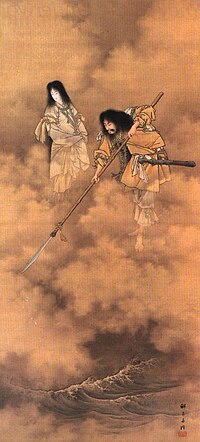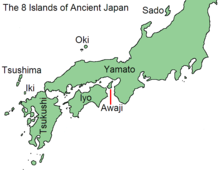Kuniumi
This article relies largely or entirely on a single source. (May 2024) |
In Japanese mythology, Kuniumi (
Creation story[edit]

According to the Kojiki[edit]
After the formation, Heaven was above and Earth was still a drifting soft mush. The first five gods named Kotoamatsukami (
This they did with the use of a precious stone-covered spear named Ame-no-nuboko (
Then they initiated conversation inquiring of each other's anatomy, leading to a mutual decision to mate and reproduce:[4]
IZANAGI:
How has your body been made?[nb 1]
IZANAMI:
My body is fully formed, except for a part which has not quite grown.[nb 2]
IZANAGI:
My body is fully formed, except I have a part that has grown too much. If I place the part of my body that has grown too much, and plug the part of your body not yet grown, we will produce lands and dominions. What say you to this?[nb 3]
Izanami accepted the offer and Izanagi proposed that both should circle around the column Ame-no-mihashira in opposite directions, Izanami going right and Izanagi left and on meeting each other would perform sexual intercourse (maguwai (
However, they mated anyway and later fathered a child Hiruko (lit. "leech child), who was placed in a reed boat dragged by the current.[nb 4] Afterwards they gave birth to Awashima (
Izanagi and Izanami decided to ascend to heaven and consult the primordial gods at Takamagahara about the ill-formed children that resulted from their union. The gods determined through divination that the female speaking first during the ceremony was the cause. So the couple returned to Onogoroshima island and repeated the rite encircling the column, only making sure Izanagi was the first to speak out in greeting. When finished, they performed the union successfully and lands began to be born.[6]
Birth of the islands[edit]
According to the legend, the formation of Japan began with the creation of eight large islands by Izanagi and Izanami. In order of birth these islands are the following:[6]

- Awaji-no-ho-no-sawake-no-shima (
淡 道之 穂 之 狭 別 島 ): currently, Awaji Island; - Iyo-no-futana-no-shima (
伊 予 之 二名 島 ): currently, Shikoku. This island had a body and four faces. The names of the faces are as follows:- Ehime (
愛 比 売 ): Iyo Province; - Ihiyorihiko (
飯 依 比 古 ): Sanuki Province; - Ohogetsuhime (
大 宣 都 比 売 ): Awa Province; - Takeyoriwake (
建 依 別 ): Tosa Province.
- Ehime (
- Oki-no-mitsugo-no-shima (
隠 伎之三子島 ): today, Oki Islands. Dubbed Ame-no-oshikorowake (天 之 忍 許 呂 別 ); - Tsukushi-no-shima (
筑紫 島 ): today, Kyūshū. This island had a body and four faces. The names of the faces are as follows:- Shirahiwake (
白日 別 ): Tsukushi Province; - Toyohiwake (
豊 日 別 ): Toyo Province; - Takehimukahitoyokujihinewake (
建 日向 日 豊久 士 比 泥 別 ): Hi Province; - Takehiwake (
建 日 別 ): Kumaso.
- Shirahiwake (
- Iki-no-shima (
伊 伎島): today, Iki Island. Dubbed Amehitotsubashira (天 比 登 都 柱 ); - Tsu-shima (
津島 ): today, Tsushima Island. Dubbed Ame-no-sadeyorihime (天 之 狭 手 依 比 売 ); - Sado-no-shima (
佐度島 ): today, Sado Island; - Ohoyamatotoyoakitsu-shima (
大倭 豊 秋津島 ): today, Honshu. Dubbed Amatsumisoratoyoakitsunewake (天 御 虚空 豊秋 津根 別 ).
Traditionally these islands are known as Ōyashima (lit. eight large islands) and as a whole are what is currently known as Japan. In the myth neither Hokkaidō nor the Ryukyu Islands are mentioned as these were not known to the Japanese at the time of compiling the Kojiki.[6]
Additionally, Izanagi and Izanami then gave birth to six islands:[6][7]
- Kibi-no-kojima (
吉備 児島 ): Kojima Peninsula of Kibi (now in Okayama). Dubbed Takehikatawake (建 日方 別 ); - Azuki-jima (
小豆島 ): Shōdoshima. Dubbed Ohonodehime (大野 手 比 売 ); - Oho-shima (
大島 ): Suō-Ōshima. Dubbed Ohotamaruwake (大 多麻 流 別 ); - Hime-jima (
女島 ): Himeshima. Dubbed Amehitotsune (天 一 根 ); - Chika-no-shima (
知 訶島): Gotō Islands. Dubbed Ame-no-oshio (天 之 忍 男 ); - Futago-no-shima (
両 児島 ): Danjo Islands. Dubbed Amefutaya (天 両 屋 ).
According to the Nihon Shoki[edit]
The story of this book only differs in that Izanagi and Izanami volunteered to consolidate the earth. In addition, the two deities are described as "god of yang" (
Notes[edit]
- ^ 「
汝 身 者 如何 成 也」 (in Old Japanese); 「あなたの体 はどのようにできていますか」 (transcription in modern Japanese). Kojiki. - ^ 「
妾 身 層 層 鑄 成 然 未成 處 有 一 處 在 」 (in Old Japanese); 「私 の体 には、成長 して、成長 していないところが1ヶ所 あります」 (transcription in modern Japanese). Kojiki. - ^ 「
吾 身 亦 層 層 鑄 也尚 有 凸 餘 處 一 故 以此吾 身 之 餘 處 刺 塞 汝 身 之 未成 處 為 完 美 態 而生國土 奈何 」 (in Old Japanese); 「私 の体 には、成長 して、成長 し過 ぎたところが1ヶ所 あります。そこで、この私 の成長 し過 ぎたところで、あなたの成長 していないところを刺 して塞 いで、国土 を生 みたいと思 います。生 むのはどうですか。」 (transcription in modern Japanese). Kojiki. - ^ Later popular legends say he became the god Ebisu. It does not say so in the Kojiki
References[edit]
- ^ a b
小向 ,正司 (1992).神道 の本 . Books Esoterica. Vol. 2.学研 . p. 27.(zasshi code 66951-07; kyōtsu zasshi code T10-66951-07-1000) - ^ Takeda (
武田 1996, p. 22 n6) - ^ Chamberlain 2008, p. 73
- ^ a b c d Chamberlain 2008, p. 74
- ^
武田 ,祐吉 (Yūkichi Takeda) [in Japanese] (1996) [1977].中村 啓 信 (ed.).新 訂 古事記 .講談社 . pp. 21–25. ISBN 4-04-400101-4. - ^ a b c d Chamberlain 2008, p. 75
- ^ Chamberlain 2008, p. 76
Bibliography[edit]
- Chamberlain, Basil Hall (2008). The Kojiki: Japanese Records of Ancient Matters. Forgotten Books. ISBN 978-1-60506-938-8. Retrieved 9 February 2011.
- "Génesis del mundo y aparición de los primeros dioses" [Genesis of the world and appearance of the first gods] (PDF) (in Spanish). Archived from the original (PDF) on 2007-11-10.


